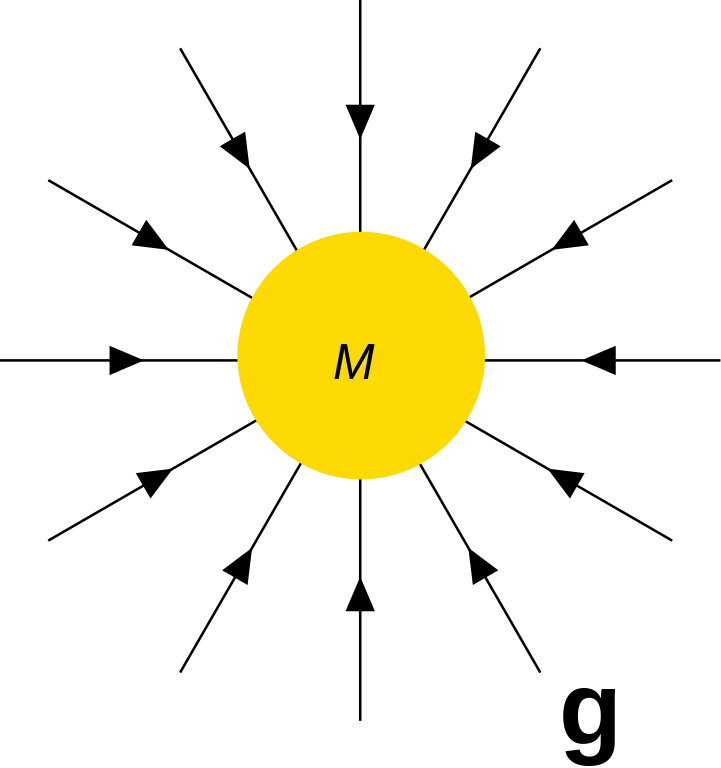
[Image1]
Introduction
Hey it's a me again @drifter1! In this article we will continue with Physics, and more specifically the branch of "Classical Mechanics". Today's article will be about Gravitational Fields. So, without further ado, let's "get pulled" straight into it!
Gravitational Field
Small Recap
In the previous articles about the topic of Gravity we stated that:
- All particles in the Universe attract each other with a force (Fgravity) that can be described by Newton's Law of Gravitation:

- This force is also called weight (w) and equal to:

- The acceleration of gravity (g) that an object has while being attracted by another through Gravity can be calculated by substituting the 2nd into the 1st equation giving:

Definition
The region in which other objects are attracted to another object (with more mass) is called a Gravitational Field. The field has infinite range, but infinitesimal forces can safely be ignored in calculations. This means that we don't have to include the graviational attraction of other planets of the Solar System when solving problems with Gravity on Earth. In the same way, we don't have to include the gravitational attraction of objects with small mass (like pizza) when their is the larger gravitational attraction caused by the mass of the whole Earth.
Mathematical Equation
A gravitational field is described by the following equation:

- g: graviational acceleration
- G: graviational constant
- M: mass of the attractor object
- |r|: distance away of the center of the object
 : unit direction vector pointing towards the object (that's also why the value is negative)
: unit direction vector pointing towards the object (that's also why the value is negative)
Modified Gravity Force Equation
Using this representation, the force of gravity (or weight) is now written as:

Gravitational Field Visualization
Gravitational Field of Single Point Mass
A gravitational field of a single mass can be drawn using vectors or "field lines" that point towards the center of mass.
Using Vectors, by decreasing the length as we move further and further away from the mass, we can visualize the decrease of strength:
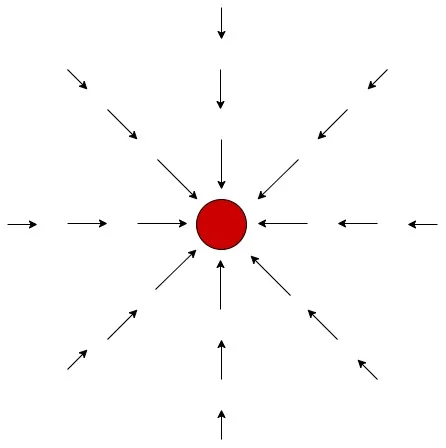
[Custom Visualization based on Ref3]
Using Lines, we just show the direction:

[Custom Visualization based on Ref3]
The Principle of Superposition
Before we get into the field caused by two or more masses, we have to talk about how we add-up the attractions. Because of the Principle of Superposition the total gravitational field is given by adding the two or more vectors together. This might sound obvious, but isn't true for every force in nature. Elementary particles and gravitational fields near black holes don't obey this principle.
Gravitational Field of Two or More Masses
To keep things simple let's suppose a point mass m is at some point P in space and attracted by three masses with the same mass M that form a triangle. Using two two-vector sums to add the forces we can easily visualize towards which position that point mass will be attracted to.
Let's first just visualize the four masses:
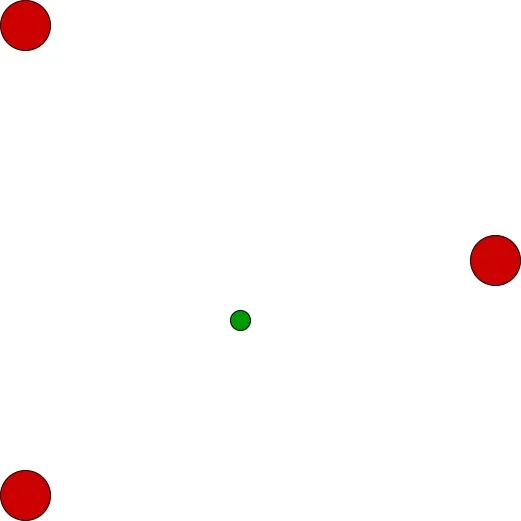
Let's now add field lines starting from mass m and heading towards each mass M:
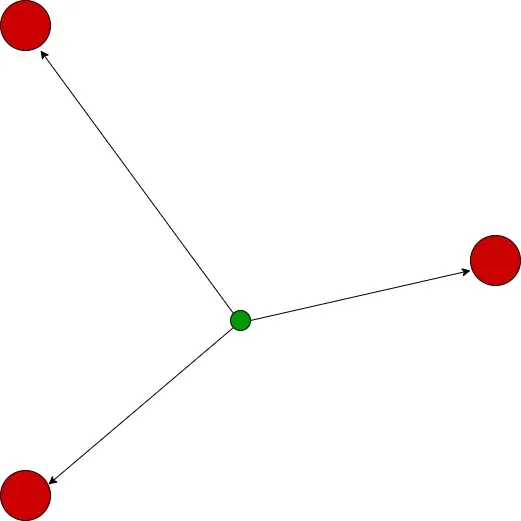
Let's (visually) calculate the sum of the gravity force vectors of the two upper masses:
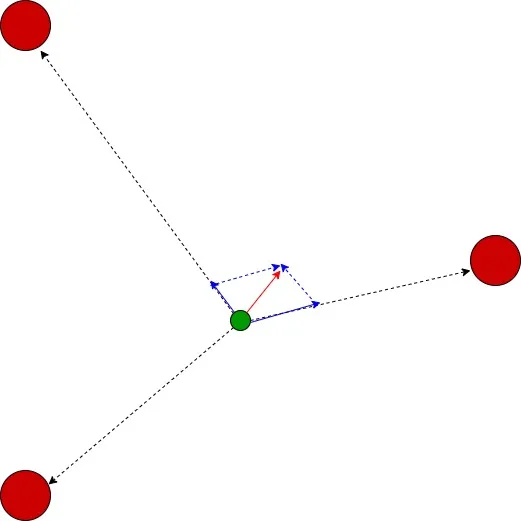
Lastly, let's calculate the total attraction vector by adding the previous result to the lower gravity vector:

The vector lengths were not accurately taken and so the result might be incorrect here.
I guess that the concept has been made clear though.
RESOURCES:
References
- https://energyeducation.ca/encyclopedia/Gravitational_field
- https://isaacphysics.org/concepts/cp_gravitational_field
- https://phys.libretexts.org/Bookshelves/Astronomy__Cosmology/Supplemental_Modules_(Astronomy_and_Cosmology)/Astronomy/Gravity/1.2%3A_Visualizing_Gravity%3A_the_Gravitational_Field
Images
Mathematical equations used in this article, where made using quicklatex.
Previous articles of the series
Rectlinear motion
- Velocity and acceleration in a rectlinear motion -> velocity, acceleration and averages of those
- Rectlinear motion with constant acceleration and free falling -> const acceleration motion and free fall
- Rectlinear motion with variable acceleration and velocity relativity -> integrations to calculate pos and velocity, relative velocity
- https://www.grc.nasa.gov/www/k-12/airplane/wteq.html
- Rectlinear motion exercises -> examples and tasks in rectlinear motion
Plane motion
- Position, velocity and acceleration vectors in a plane motion -> position, velocity and acceleration in plane motion
- Projectile motion as a plane motion -> missile/bullet motion as a plane motion
- Smooth Circular motion -> smooth circular motion theory
- Plane motion exercises -> examples and tasks in plane motions
Newton's laws and Applications
- Force and Newton's first law -> force, 1st law
- Mass and Newton's second law -> mass, 2nd law
- Newton's 3rd law and mass vs weight -> mass vs weight, 3rd law, friction
- Applying Newton's Laws -> free-body diagram, point equilibrium and 2nd law applications
- Contact forces and friction -> contact force, friction
- Dynamics of Circular motion -> circular motion dynamics, applications
- Object equilibrium and 2nd law application examples -> examples of object equilibrium and 2nd law applications
- Contact force and friction examples -> exercises in force and friction
- Circular dynamic and vertical circle motion examples -> exercises in circular dynamics
- Advanced Newton law examples -> advanced (more difficult) exercises
Work and Energy
- Work and Kinetic Energy -> Definition of Work, Work by a constant and variable Force, Work and Kinetic Energy, Power, Exercises
- Conservative and Non-Conservative Forces -> Conservation of Energy, Conservative and Non-Conservative Forces and Fields, Calculations and Exercises
- Potential and Mechanical Energy -> Gravitational and Elastic Potential Energy, Conservation of Mechanical Energy, Problem Solving Strategy & Tips
- Force and Potential Energy -> Force as Energy Derivative (1-dim) and Gradient (3-dim)
- Potential Energy Diagrams -> Energy Diagram Interpretation, Steps and Example
- Internal Energy and Work -> Internal Energy, Internal Work
Momentum and Impulse
- Conservation of Momentum -> Momentum, Conservation of Momentum
- Elastic and Inelastic Collisions -> Collision, Elastic Collision, Inelastic Collision
- Collision Examples -> Various Elastic and Inelastic Collision Examples
- Impulse -> Impulse with Example
- Motion of the Center of Mass -> Center of Mass, Motion analysis with examples
- Explaining the Physics behind Rocket Propulsion -> Required Background, Rocket Propulsion Analysis
Angular Motion
- Angular motion basics -> Angular position, velocity and acceleration
- Rotation with constant angular acceleration -> Constant angular acceleration, Example
- Rotational Kinetic Energy & Moment of Inertia -> Rotational kinetic energy, Moment of Inertia
- Parallel Axis Theorem -> Parallel axis theorem with example
- Torque and Angular Acceleration -> Torque, Relation to Angular Acceleration, Example
- Rotation about a moving axis (Rolling motion) -> Fixed and moving axis rotation
- Work and Power in Angular Motion -> Work, Work-Energy Theorem, Power
- Angular Momentum -> Angular Momentum and its conservation
- Explaining the Physics behind Mechanical Gyroscopes -> What they are, History, How they work (Precession, Mathematical Analysis) Difference to Accelerometers
- Exercises around Angular motion -> Angular motion examples
Equilibrium and Elasticity
- Rigid Body Equilibrium -> Equilibrium Conditions of Rigid Bodies, Center of Gravity, Solving Equilibrium Problems
- Force Couple System -> Force Couple System, Example
- Tensile Stress and Strain -> Tensile Stress, Tensile Strain, Young's Modulus, Poisson's Ratio
- Volumetric Stress and Strain -> Volumetric Stress, Volumetric Strain, Bulk's Modulus of Elasticity, Compressibility
- Cross-Sectional Stress and Strain -> Shear Stress, Shear Strain, Shear Modulus
- Elasticity and Plasticity of Common Materials -> Elasticity, Plasticity, Stress-Strain Diagram, Fracture, Common Materials
- Rigid Body Equilibrium Exercises -> Center of Gravity Calculation, Equilibrium Problems
- Exercises on Elasticity and Plasticity -> Young Modulus, Bulk Modulus and Shear Modulus Examples
Gravity
- Newton's Law of Gravitation -> Newton's Law of Gravity, Gravitational Constant G
- Weight: The Force of Gravity -> Weight, Gravitational Acceleration, Gravity on Earth and Planets of the Solar System
Final words | Next up
And this is actually it for today's post!Next time we will talk about Gravitational Potential Energy
See ya!


